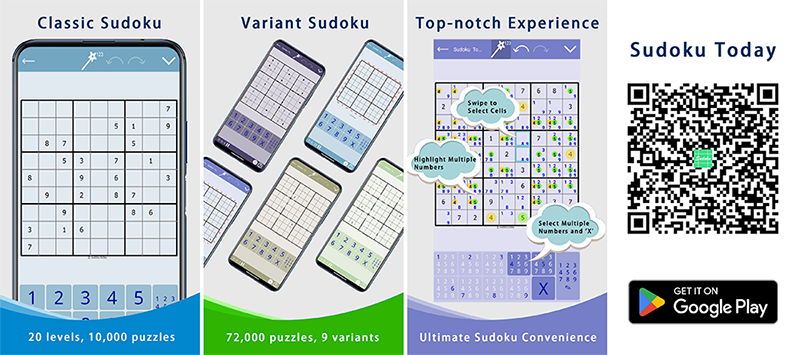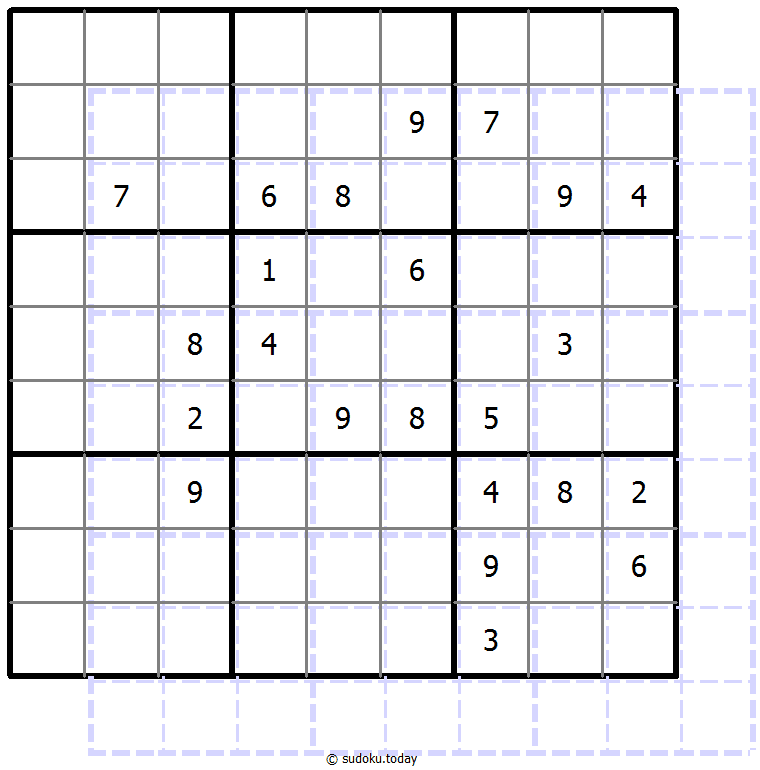Welcome to Sudoku Today!
Welcome to Sudoku.today! Enjoy daily Sudoku puzzles including classic Sudoku and over 50 unique variants. Challenge your mind every day with new puzzles!
Today's Sudoku
10 December 2025
Creasing Sudoku
- Place a digit from 1 to 9 into each of the empty squares so that each digit appears exactly once in each of the rows, columns and the nine outlined 3x3 regions.
- Digits along each line are monotonically increasing or decreasing.
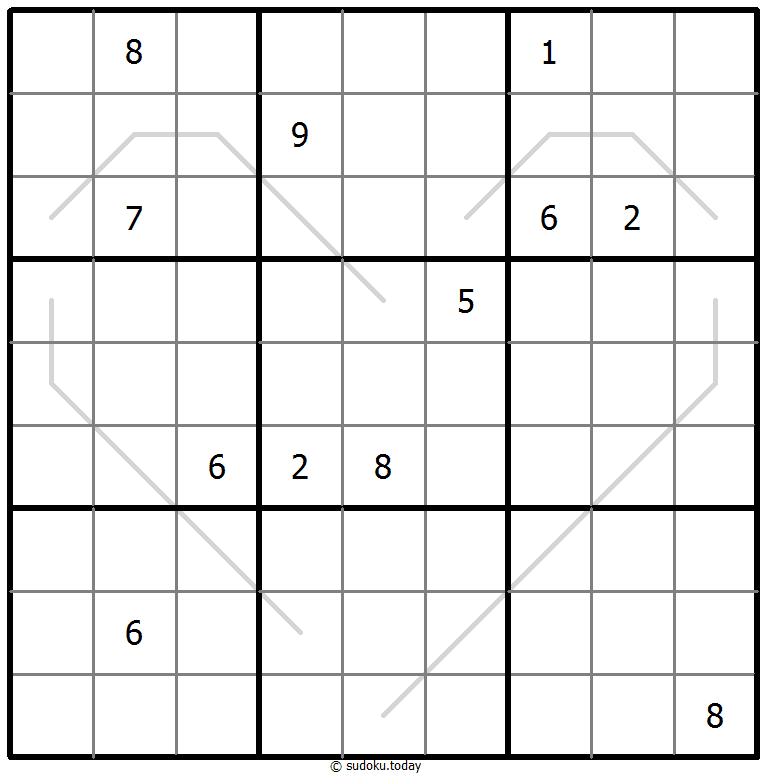
Creasing Sudoku
- Place a digit from 1 to 9 into each of the empty squares so that each digit appears exactly once in each of the rows, columns and the nine outlined 3x3 regions.
- Digits along each line are monotonically increasing or decreasing.
Hybrid Sudoku ( X Sums + Greater Than )
- Place a digit from 1 to 9 into each of the empty squares so that each digit appears exactly once in each of the rows, columns and the nine outlined 3x3 regions.
- Each number outside the grid is the sum of the first X numbers placed in the corresponding direction, where X is equal to the first number placed in that direction.
- Digits have to be place in accordance with the “greater than” signs.
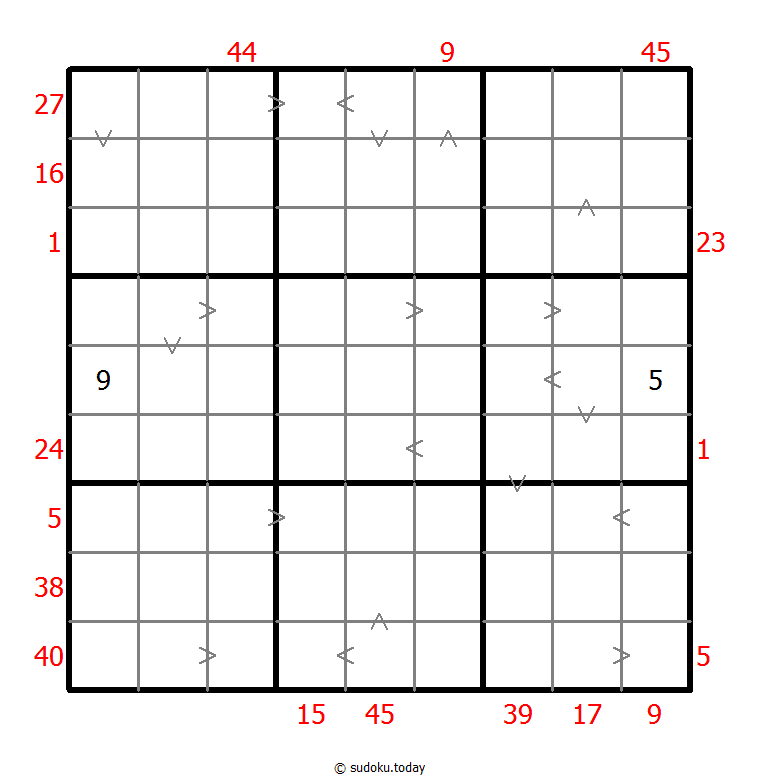
Hybrid Sudoku ( X Sums + Greater Than )
- Place a digit from 1 to 9 into each of the empty squares so that each digit appears exactly once in each of the rows, columns and the nine outlined 3x3 regions.
- Each number outside the grid is the sum of the first X numbers placed in the corresponding direction, where X is equal to the first number placed in that direction.
- Digits have to be place in accordance with the “greater than” signs.
Group Sum Sudoku
- Place a digit from 1 to 9 into each of the empty squares so that each digit appears exactly once in each of the rows, columns and the nine outlined 3x3 regions.
- Each number at the intersection of four cells is the sum of digits in those four cells.

Group Sum Sudoku
- Place a digit from 1 to 9 into each of the empty squares so that each digit appears exactly once in each of the rows, columns and the nine outlined 3x3 regions.
- Each number at the intersection of four cells is the sum of digits in those four cells.
X Sums Sudoku
- Place a digit from 1 to 9 into each of the empty squares so that each digit appears exactly once in each of the rows, columns and the nine outlined 3x3 regions.
- Each number outside the grid is the sum of the first X numbers placed in the corresponding direction, where X is equal to the first number placed in that direction.
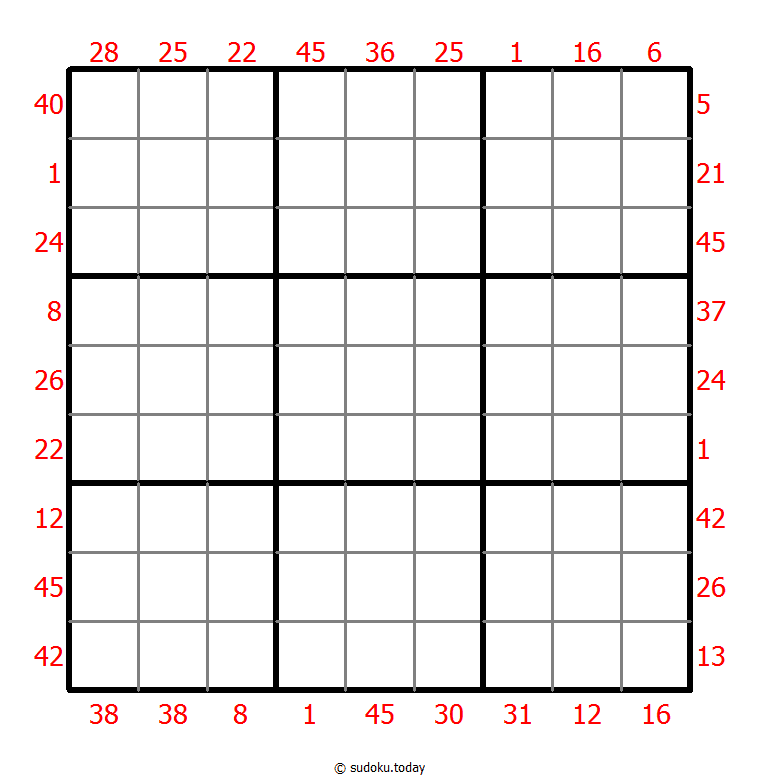
X Sums Sudoku
- Place a digit from 1 to 9 into each of the empty squares so that each digit appears exactly once in each of the rows, columns and the nine outlined 3x3 regions.
- Each number outside the grid is the sum of the first X numbers placed in the corresponding direction, where X is equal to the first number placed in that direction.
Parity Lines Sudoku
- Place a digit from 1 to 9 into each of the empty squares so that each digit appears exactly once in each of the rows, columns and the nine outlined 3x3 regions.
- Digits along each marked line are either all odd or all even.
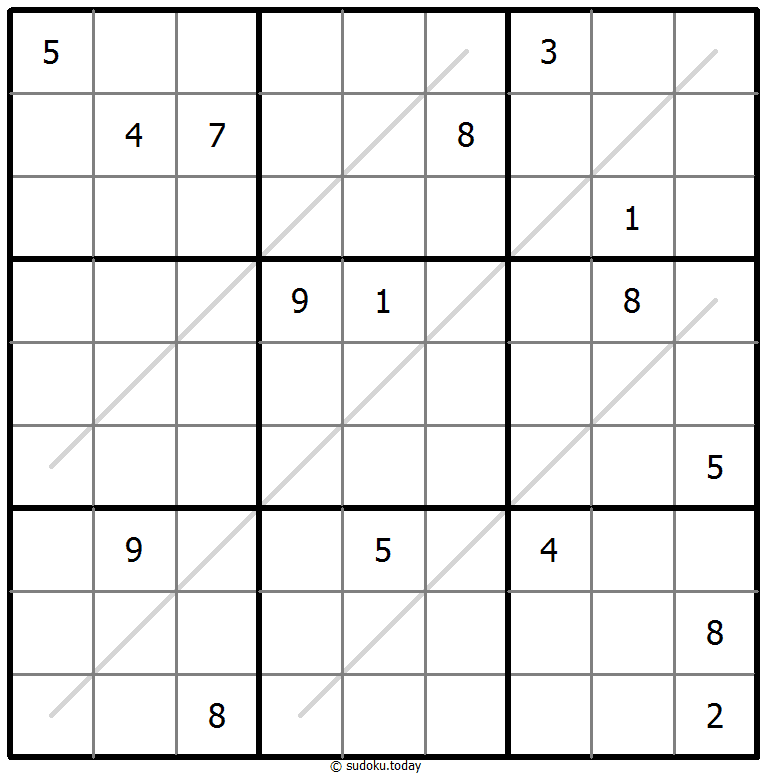
Parity Lines Sudoku
- Place a digit from 1 to 9 into each of the empty squares so that each digit appears exactly once in each of the rows, columns and the nine outlined 3x3 regions.
- Digits along each marked line are either all odd or all even.
Sujiken
- Place a digit from 1 to 9 into each of the empty squares so that each digit appears exactly once in each of the rows, columns and the nine outlined 3x3 regions.
- Sujiken (from Japanese "sujikai", literally "diagonal") is a variation of Sudoku . The puzzle consists of a triangular grid of cells containing digits from 1 to 9. The objective is to fill a grid with digits so that each cell contains a digit and no digit is repeated in any column, row and diagonal in any direction. Also, no digit occurs twice in any of the three larger 3 x 3 square regions and any of the three larger triangular regions enclosed by thick borders.

Sujiken
- Place a digit from 1 to 9 into each of the empty squares so that each digit appears exactly once in each of the rows, columns and the nine outlined 3x3 regions.
- Sujiken (from Japanese "sujikai", literally "diagonal") is a variation of Sudoku . The puzzle consists of a triangular grid of cells containing digits from 1 to 9. The objective is to fill a grid with digits so that each cell contains a digit and no digit is repeated in any column, row and diagonal in any direction. Also, no digit occurs twice in any of the three larger 3 x 3 square regions and any of the three larger triangular regions enclosed by thick borders.
Sum Frame Sudoku
- Place a digit from 1 to 9 into each of the empty squares so that each digit appears exactly once in each of the rows, columns and the nine outlined 3x3 regions.
- Digits outside the grid indicate the sum of the first 3 digits in the corresponding direction.
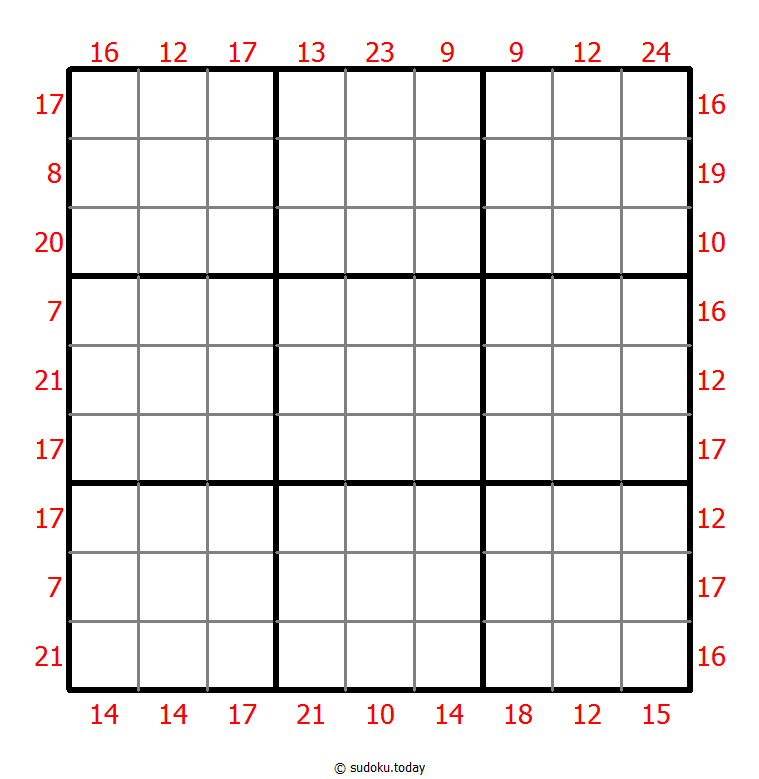
Sum Frame Sudoku
- Place a digit from 1 to 9 into each of the empty squares so that each digit appears exactly once in each of the rows, columns and the nine outlined 3x3 regions.
- Digits outside the grid indicate the sum of the first 3 digits in the corresponding direction.
Kropki Sudoku
- Place a digit from 1 to 9 into each of the empty squares so that each digit appears exactly once in each of the rows, columns and the nine outlined 3x3 regions.
- If absolute difference between two digits in neighbouring cells equals 1, then they are separated by a white dot. If the digit is a half of digit in the neighbouring cell, then they are separated by black dot. The dot between 1 and 2 can be either white or black.
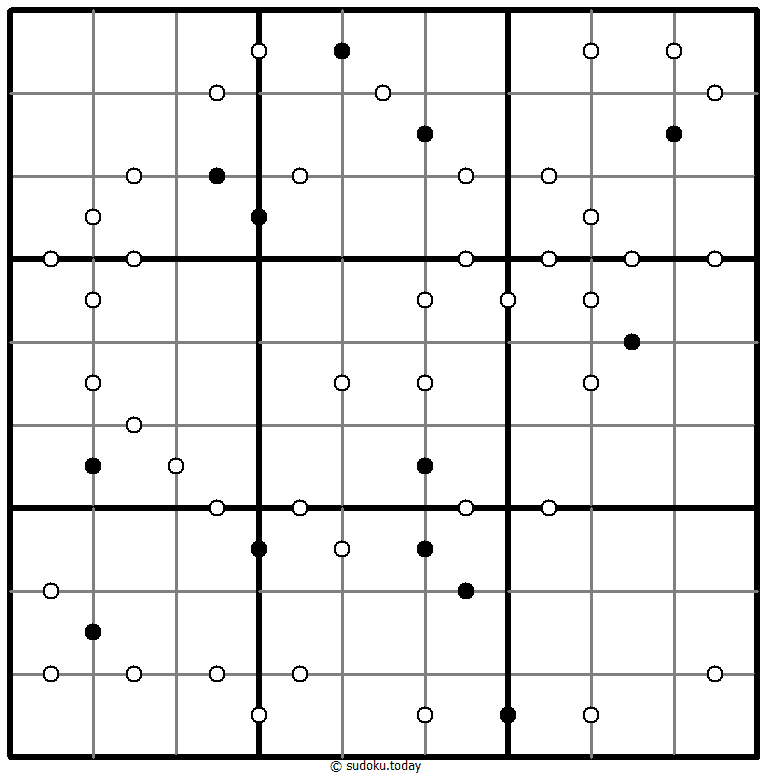
Kropki Sudoku
- Place a digit from 1 to 9 into each of the empty squares so that each digit appears exactly once in each of the rows, columns and the nine outlined 3x3 regions.
- If absolute difference between two digits in neighbouring cells equals 1, then they are separated by a white dot. If the digit is a half of digit in the neighbouring cell, then they are separated by black dot. The dot between 1 and 2 can be either white or black.
Hybrid Sudoku ( X Sums + Consecutive )
- Place a digit from 1 to 9 into each of the empty squares so that each digit appears exactly once in each of the rows, columns and the nine outlined 3x3 regions.
- Each number outside the grid is the sum of the first X numbers placed in the corresponding direction, where X is equal to the first number placed in that direction.
- There are some dots between cells. The numbers on each side of a dot must always be consecutive. Not all possible dots are marked.
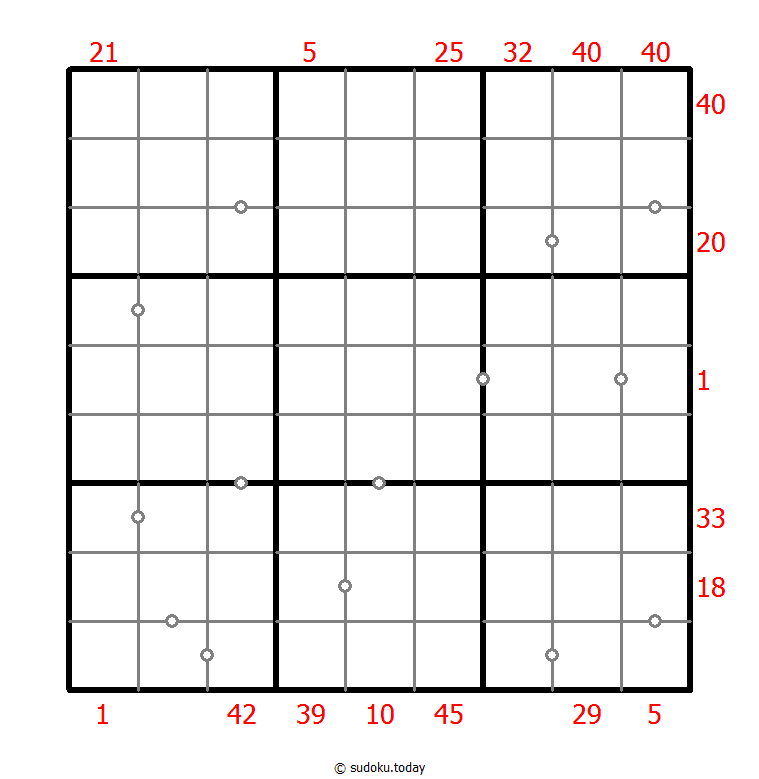
Hybrid Sudoku ( X Sums + Consecutive )
- Place a digit from 1 to 9 into each of the empty squares so that each digit appears exactly once in each of the rows, columns and the nine outlined 3x3 regions.
- Each number outside the grid is the sum of the first X numbers placed in the corresponding direction, where X is equal to the first number placed in that direction.
- There are some dots between cells. The numbers on each side of a dot must always be consecutive. Not all possible dots are marked.
Give me Five Sudoku
- Place a digit from 1 to 9 into each of the empty squares so that each digit appears exactly once in each of the rows, columns and the nine outlined 3x3 regions.
- Sum and difference of two orthogonally adjacent numbers must not be 5.
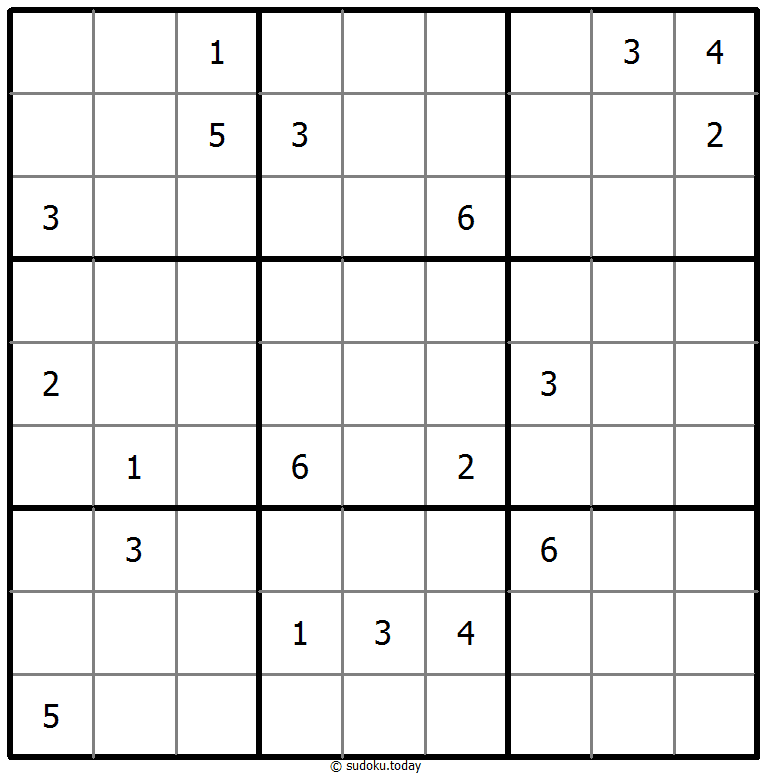
Give me Five Sudoku
- Place a digit from 1 to 9 into each of the empty squares so that each digit appears exactly once in each of the rows, columns and the nine outlined 3x3 regions.
- Sum and difference of two orthogonally adjacent numbers must not be 5.
Sums Sudoku
- Place a digit from 1 to 9 into each of the empty squares so that each digit appears exactly once in each of the rows, columns and the nine outlined 3x3 regions.
- A number between two cells indicates the sum of the numbers in these cells. A number between four cells indicates the sum between two diagonally adjacent cells, either top left + right bottom (\) or top right + bottom left (/).
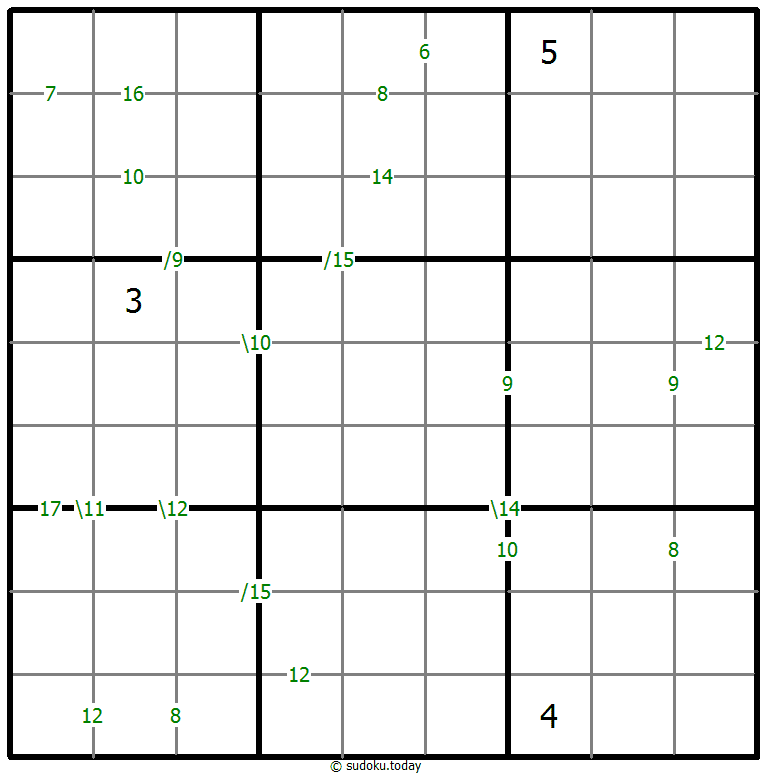
Sums Sudoku
- Place a digit from 1 to 9 into each of the empty squares so that each digit appears exactly once in each of the rows, columns and the nine outlined 3x3 regions.
- A number between two cells indicates the sum of the numbers in these cells. A number between four cells indicates the sum between two diagonally adjacent cells, either top left + right bottom (\) or top right + bottom left (/).
Little killer sudoku
- Place a digit from 1 to 9 into each of the empty squares so that each digit appears exactly once in each of the rows, columns and the nine outlined 3x3 regions.
- Numbers with arrows indicate sum of the numbers in each direction.
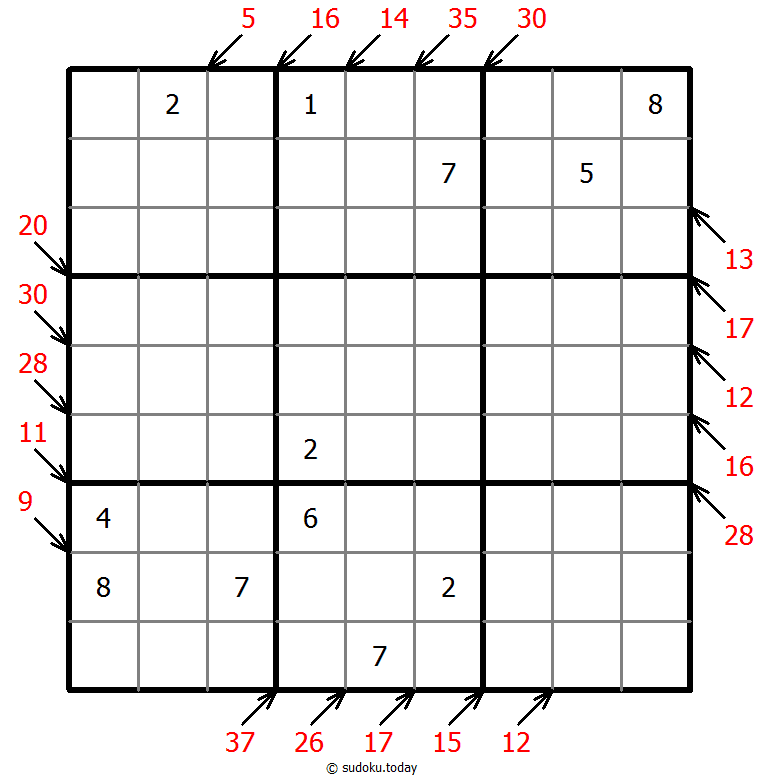
Little killer sudoku
- Place a digit from 1 to 9 into each of the empty squares so that each digit appears exactly once in each of the rows, columns and the nine outlined 3x3 regions.
- Numbers with arrows indicate sum of the numbers in each direction.
Palindrome Sudoku
- Place a digit from 1 to 9 into each of the empty squares so that each digit appears exactly once in each of the rows, columns and the nine outlined 3x3 regions.
- Digits along each line read the same from both directions.
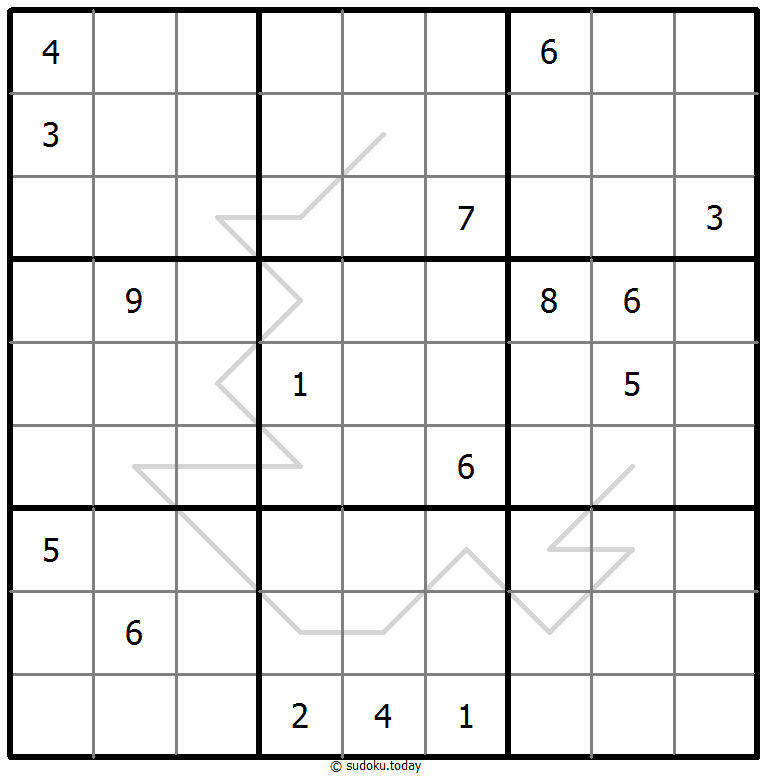
Palindrome Sudoku
- Place a digit from 1 to 9 into each of the empty squares so that each digit appears exactly once in each of the rows, columns and the nine outlined 3x3 regions.
- Digits along each line read the same from both directions.
Non-Consecutive Sudoku
- Place a digit from 1 to 9 into each of the empty squares so that each digit appears exactly once in each of the rows, columns and the nine outlined 3x3 regions.
- Digits in adjacent cells cannot be consecutive.
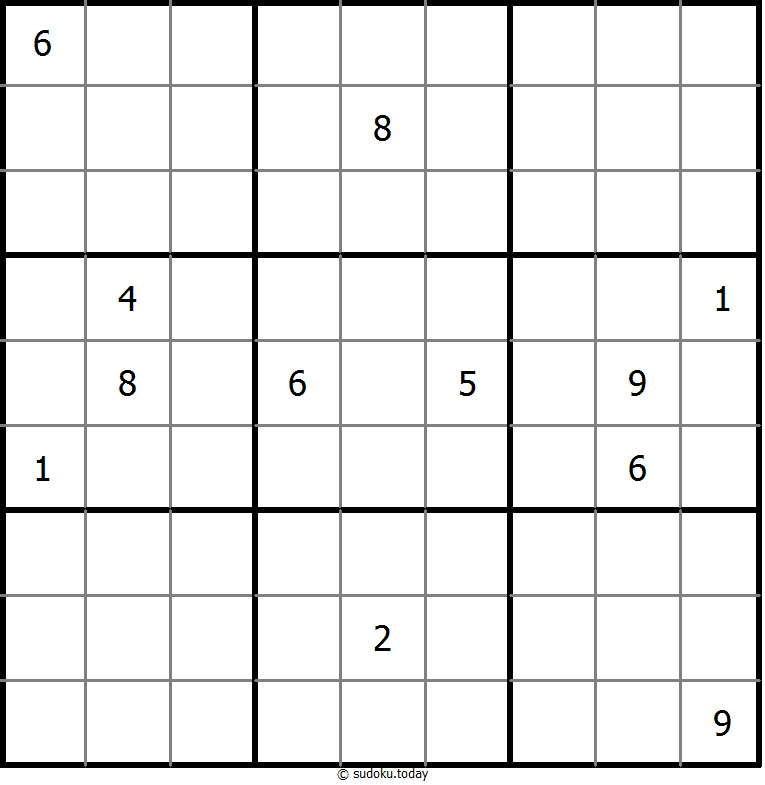
Non-Consecutive Sudoku
- Place a digit from 1 to 9 into each of the empty squares so that each digit appears exactly once in each of the rows, columns and the nine outlined 3x3 regions.
- Digits in adjacent cells cannot be consecutive.
Clone Sudoku
- Place a digit from 1 to 9 into each of the empty squares so that each digit appears exactly once in each of the rows, columns and the nine outlined 3x3 regions.
- Grey cells in the grid represent many cloned areas. Digits in these areas on corresponding positions must be identical. Cloned areas are only moved, without rotation or reflection.
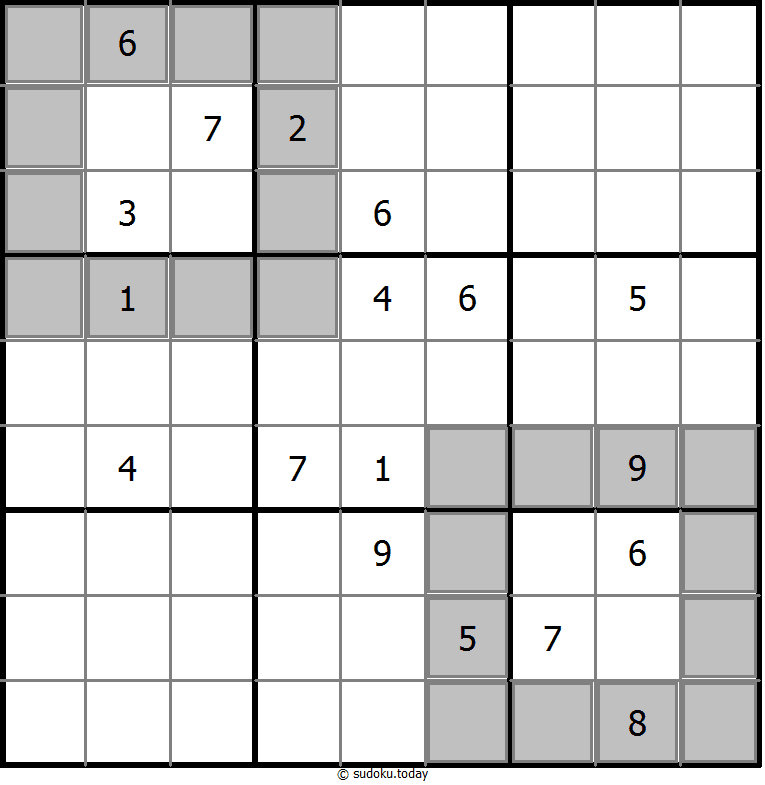
Clone Sudoku
- Place a digit from 1 to 9 into each of the empty squares so that each digit appears exactly once in each of the rows, columns and the nine outlined 3x3 regions.
- Grey cells in the grid represent many cloned areas. Digits in these areas on corresponding positions must be identical. Cloned areas are only moved, without rotation or reflection.
Greater Than Sudoku
- Place a digit from 1 to 9 into each of the empty squares so that each digit appears exactly once in each of the rows, columns and the nine outlined 3x3 regions.
- Digits have to be place in accordance with the “greater than” signs.
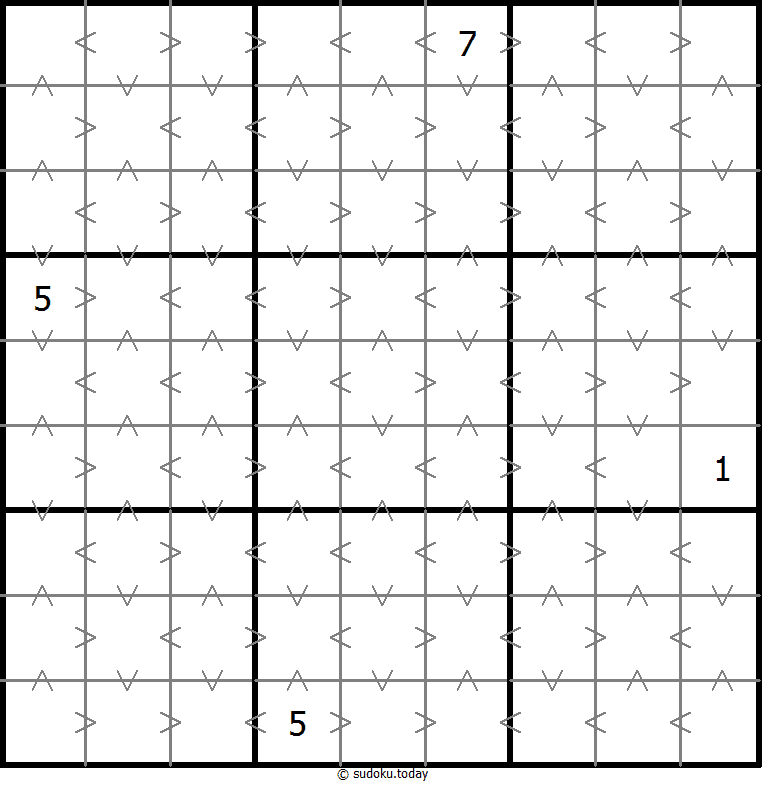
Greater Than Sudoku
- Place a digit from 1 to 9 into each of the empty squares so that each digit appears exactly once in each of the rows, columns and the nine outlined 3x3 regions.
- Digits have to be place in accordance with the “greater than” signs.
Multi Diagonal Sudoku
- Place a digit from 1 to 9 into each of the empty squares so that each digit appears exactly once in each of the rows, columns and the nine outlined 3x3 regions.
- Digits do not repeat along the marked diagonals.
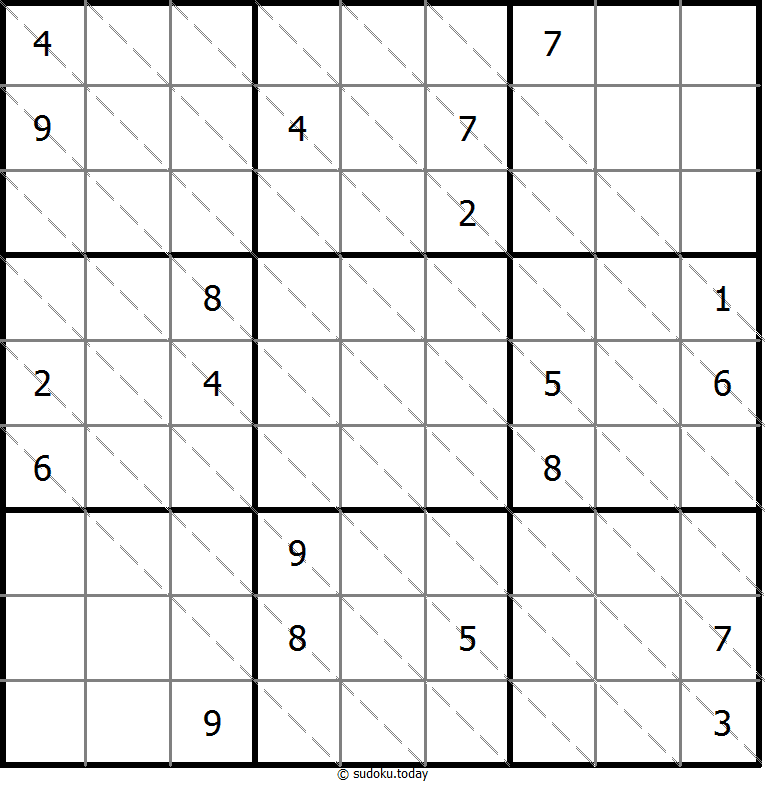
Multi Diagonal Sudoku
- Place a digit from 1 to 9 into each of the empty squares so that each digit appears exactly once in each of the rows, columns and the nine outlined 3x3 regions.
- Digits do not repeat along the marked diagonals.
Non XV sudoku
- Place a digit from 1 to 9 into each of the empty squares so that each digit appears exactly once in each of the rows, columns and the nine outlined 3x3 regions.
- The digits in two orthogonally adjacent cells cannot have a sum of either 5 or 10.

Non XV sudoku
- Place a digit from 1 to 9 into each of the empty squares so that each digit appears exactly once in each of the rows, columns and the nine outlined 3x3 regions.
- The digits in two orthogonally adjacent cells cannot have a sum of either 5 or 10.
Mathrax Sudoku
- Place a digit from 1 to 9 into each of the empty squares so that each digit appears exactly once in each of the rows, columns and the nine outlined 3x3 regions.
- Some intersections of the grid lines are marked by a number and an operator (+, -, x, /) in a circle. The number is the result of the operation, applied to both pairs of diagonally opposite cells. An E in the circle indicates that all four adjacent digits are even, while an O indicates that all four adjacent digits are odd.
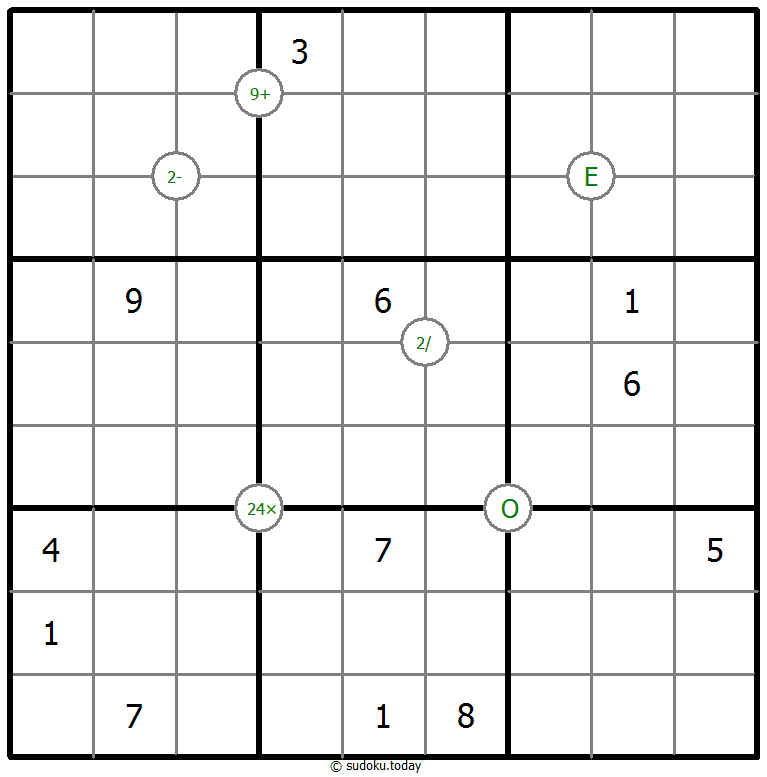
Mathrax Sudoku
- Place a digit from 1 to 9 into each of the empty squares so that each digit appears exactly once in each of the rows, columns and the nine outlined 3x3 regions.
- Some intersections of the grid lines are marked by a number and an operator (+, -, x, /) in a circle. The number is the result of the operation, applied to both pairs of diagonally opposite cells. An E in the circle indicates that all four adjacent digits are even, while an O indicates that all four adjacent digits are odd.
English | 中文(简体) | 中文(繁體) | 日本語 | 한국어 | Français | Deutsch | Español | Português | Русский | Italiano | Nederlands | Türkçe | हिन्दी | ไทย | Tiếng Việt | Bahasa Indonesia | Polski | Українська |
数独 | Cool Sudoku | 数独 | Sudoku Puzzle | 賢くなるパズル
© sudoku.today All rights reserved 2019-2025

